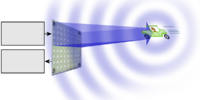
Photo from wikipedia
In situ observations, satellite observations, and regional observations from airborne remote sensing are very useful to characterize sea state evolution and related physical processes, improve numerical modeling, and contribute to… Click to show full abstract
In situ observations, satellite observations, and regional observations from airborne remote sensing are very useful to characterize sea state evolution and related physical processes, improve numerical modeling, and contribute to climate variable survey. Directional wave spectra describe the complexity of sea state and give access to parameters such as directional parameters (mean direction and directional distribution of energy) and frequency parameters (peak frequency, frequency spread). In this paper, directional ocean wave spectra and their parameters, retrieved from observations carried out with the airborne radar system KuROS during two field campaigns, are analyzed. These campaigns provide a very rich variety of meteorological conditions: high wind conditions either fetch-limited cases or mature sea conditions and moderate wind conditions and sea state dominated by swell. The objective of this paper is to compare the KuROS data set with numerical wave model outputs and buoy observations. This comparison aims first at assessing the performances on main wave parameters (significant wave height, mean direction at the peak, peak frequency) retrieved from KuROS in different conditions (wind sea, swell, mixed seas), and then, to discuss on parameters characterizing the shape of the wave spectra, namely the frequency and the directional spread. Results of the comparisons show that, due to the size of the KuROS radar footprint, ocean waves with dominant wavelengths lower than 200 m are the most appropriate situations for wave retrieval. They also show an overestimation of the model frequency spread and an underestimation of the model directional spread compare to KuROS and buoy data for both campaigns.
Journal Title: Ocean Dynamics
Year Published: 2019
Link to full text (if available)
Share on Social Media: Sign Up to like & get
recommendations!